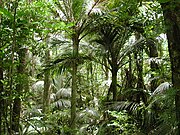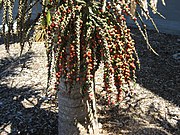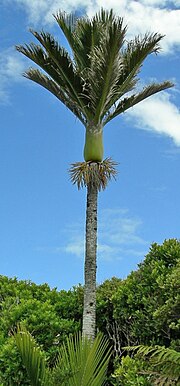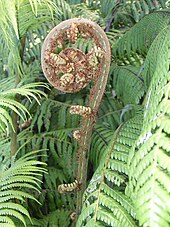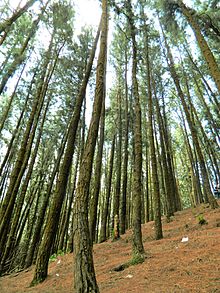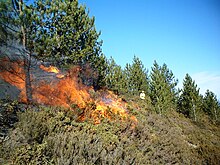PAGES
Sunday, 31 December 2017
HIDDEN LAKE IN WAITOMO
This hidden lake is situated on limestone hill county in Waitomo, and is contiguous with two QEII sites (S16068, S16069 ), and Orahiri Scenic Reserve (S16038). The site is near Ruakauri Caves and Bush Scenic Reserve (S16031), whic is habitat for several threatened species. The site was described in the SSWI survey as regenerating forest of rewarewa/mixed hardwood with a manuka margin.The surevey noted common forest birds and bellbird
PALM TREE ( Nikau )
Nikau
From Wikipedia, the free encyclopedia
For the New Zealand rugby league player, see Tawera Nikau.
| Nīkau | |
|---|---|
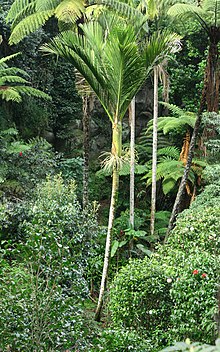 | |
| Scientific classification | |
| Kingdom: | Plantae |
| (unranked): | Angiosperms |
| (unranked): | Monocots |
| (unranked): | Commelinids |
| Order: | Arecales |
| Family: | Arecaceae |
| Subtribe: | Rhopalostylidinae |
| Genus: | Rhopalostylis |
| Species: | R. sapida |
| Binomial name | |
| Rhopalostylis sapida H.Wendl. & Drude | |
The nīkau (Rhopalostylis sapida) is a palm tree endemic to New Zealand, and the only palm native to New Zealand.
Contents
[hide]Etymology[edit]
Nīkau is a Māori word; in the closely related Eastern Polynesian languages of the tropical Pacific, it refers to the fronds or the midrib of the coconut palm.[1]
Distribution[edit]
The nīkau palm is the only palm species endemic to mainland New Zealand. Its natural range is coastal and lowland forest on the North Island, and on the South Island as far south as Okarito mostly in humidity (43°20′S) in the west and Banks Peninsula (43°5′S) in the east. It also occurs on Chatham Island and Pitt Island/Rangiauria to the south-east of New Zealand, where it is the world's southernmost palm at 44° 18'S latitude.[2]
The nīkau grows up to 15 m tall, with a stout, green trunk which bears grey-green leaf scars. The trunk is topped by a smooth, bulging crownshaft up to 1m long. The fronds are up to 3 m long, and the closely set, sometimes overlapping leaflets are up to 1 m long. The inflorescence is multibranched and from 200 to 400 mm long. The tightly packed flowers are unisexual and coloured lilac to pink. Male flowers are borne in pairs, and have six stamens. The female flowers are solitary. The fruit is elliptic or oblong, and generally measures about 10 by 7 mm, and is red when ripe. The nīkau produces flowers between November and April, and fruits ripen from February to November, taking almost a year to fully ripen. These are a preferred food of the kererū, the native wood pigeon.
Cultivation[edit]
The nīkau makes an excellent potted plant, and is quite hardy. It tends to be slow-growing. It grows readily from seed if the fruit is soaked in water for a few days and then gently scrubbed to remove the flesh. The seed will then germinate readily if placed in sealed plastic bags in partial shade, after which they can be planted in deep pots. The pots should be tall and narrow to provide room for the taproot and to lessen the likelihood of root damage when transplanting.
Transplanting juveniles is generally successful if the main root is left intact. The nīkau does not have a true tap root. Once the main root has been established to a fairly shallow depth of about 400 mm, its roots take on form consistent with other palms. Successful transplanting is possible, but nīkau is very fickle if any trunk is present. It is best done in summer, but a substantial root ball should be preserved, and shade should be provided at the new location - at the very least by tying the outer fronds closer to the centre. Ground watering is recommended because crown watering can induce terminal rot at the very slow-growing new spike. Delays should be avoided in getting the nīkau into its new ground, and substantial die-back of all but the central spike can be expected.
The nīkau thrives on cool temperatures, but is not subject to freezing weather in its natural habitat. It can survive a few degrees of frost, but it is damaged even more severely by sudden large drops in temperature even above freezing. It does well in areas with a mild Mediterranean climate.
Variation[edit]
The nīkau palm shows considerable variation in the wild. Plants from the South Island and the offshore islands of the North Island have larger, more-gracefully-arching fronds and are popular in cultivation. The Chatham Islandsform is particularly different, having a distinct juvenile form and larger fruits, and a thicker covering of fine hairs on the fronds. More research is needed into its precise relationship with the mainland form. The New Zealand nīkau palm is very similar to Rhopalostylis baueri of the Kermadecs and Norfolk Island, which can be distinguished by its more rounded or oval fruits, and by its leaflets which are broader than those found in most populations of R. sapida.
Uses[edit]
Maori found many uses for the nīkau palm. The bases of the inner leaves and the young flower clusters were eaten raw or cooked. Food was wrapped in the leaves for cooking, and the old fibrous leaves were used for baskets, floor mats, and waterproof thatch for buildings.[2]
Silver fern tree
Cyathea dealbata
From Wikipedia, the free encyclopedia
"Silver Fern" redirects here. For other uses, see Silver Fern (disambiguation).
| Silver fern | |
|---|---|
 | |
| Frond, showing silver underside | |
| Scientific classification | |
| Kingdom: | Plantae |
| Division: | Pteridophyta |
| Class: | Pteridopsida |
| Order: | Cyatheales |
| Family: | Cyatheaceae |
| Genus: | Cyathea |
| Subgenus: | Cyathea |
| Section: | Alsophila |
| Species: | C. dealbata |
| Binomial name | |
| Cyathea dealbata (G. Forster) Swartz, 1801 | |
| Synonyms | |
| |

An Air New Zealand ATR 72-600with a stylised koru on the tail and otherwise painted in all black livery with a silver fern on the fuselage.
Cyathea dealbata, also known as the silver tree-fern[1] or silver fern, or as ponga /ˈpɒŋə/ or punga /ˈpʌŋə/ (from Māori kaponga or ponga), is a species of medium-sized tree fern, endemic to New Zealand.[2] It is a symbol commonly associated with the country both overseas and by New Zealanders themselves.[3]
This fern is known to grow to heights of 10 m or more (though it occasionally takes a rare creeping form). The crown is dense, and the frondstend to be about 4 m long and have a silver-white colouration on the undersides. This distinctive silver colouration has made them useful for laying along tracks for night walking. The scales are a dark brown and are often twisted and glossy.[4]
Arriving relatively late in New Zealand's history during the Pliocene epoch[5] (around 5.0–1.8 million years ago), the silver fern occurs on the main islands of New Zealand and on the Chatham Islands to the east, mostly in the subcanopy areas of drier forests and in open scrub. It is known to grow well in well-drained humus, and once established, it will tolerate drier conditions. It does best when sheltered from winds and should be protected from frost.
In culture[edit]
- The earliest use of the silver fern as an official national symbol was by the New Zealand Army during the Second Boer War. Since then, the silver fern has been used by the New Zealand Expeditionary Forces during both World Wars and all Commonwealth war graves of fallen New Zealand soldiers have the silver fern engraved on their tombstones. During the 1956 Suez Crisis, Egyptians took exception to New Zealand and Canadian peacekeepers having the Union Flag on their uniforms. Canadian troops wore the Maple Leaf whereas the New Zealand contingent wore a silver fern symbol. New Zealand peacekeepers have since used both the silver fern and kiwi symbols for different deployments to differentiate from their Australian and British counterparts.
- The silver fern has long been used on dairy products, including the logo of New Zealand Natural, and was trademarked as early as 1885.
- Silver fern leaves appear on the coat of arms of New Zealand.
- It is a logo for many other organisations, such as (heavily stylised) the rail operator KiwiRail. The Silver Fern is also the name of a class of railcar.
- Many New Zealanders get a tattoo of a Silver Fern, as a statement of being from New Zealand.[citation needed]
- Some alternative flags for New Zealand, such as the silver fern flag, use the silver fern. The official proposal of the New Zealand flag referendums, 2015–16 featured the fern.
- The silver fern is also used extensively within politics and printed material, such as the logo of the former New Zealand Progressive Party.
- The koru symbol is inspired by the shape of an unfurling silver fern frond. It is found extensively in Māori art, from carving to the official Māori flag and is used in a stylised form as the logo for national airline Air New Zealand.
In short, the fern has become one of the most widely recognised symbols of New Zealand, next to the Kiwi, though it is not an official symbol.[3]
Pine Trees
From Wikipedia, the free encyclopedia
This article is about the tree. For other uses of the term "pine", see Pine (disambiguation).
| Pine tree | |
|---|---|
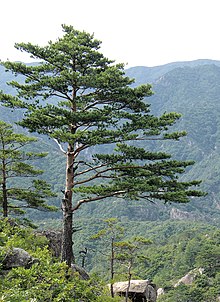 | |
| Japanese red pine (Pinus densiflora), North Korea | |
| Scientific classification | |
| Kingdom: | Plantae |
| Division: | Pinophyta |
| Class: | Pinopsida |
| Order: | Pinales |
| Family: | Pinaceae |
| Subfamily: | Pinoideae |
| Genus: | Pinus L. |
| Subgenera | |
See Pinus classification for complete taxonomy to species level. See list of pines by regionfor list of species by geographic distribution.
| |
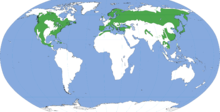 | |
| Range of Pinus | |
A pine is any conifer in the genus Pinus, /ˈpiːnuːs/,[1] of the family Pinaceae. Pinus is the sole genus in the subfamily Pinoideae. The Plant List compiled by the Royal Botanic Gardens, Kew and Missouri Botanical Garden accepts 126 species names of pines as current, together with 35 unresolved species and many more synonyms.[2]
Contents
[hide]Etymology[edit]
The modern English name "pine" derives from Latin pinus, which some have traced to the Indo-European base *pīt- ‘resin’ (source of English pituitary).[3] Before the 19th century, pines were often referred to as firs (from Old Norse fura, by way of Middle English firre). In some European languages, Germanic cognates of the Old Norse name are still in use for pines—in Danish fyr, in Norwegian fura/fure/furu, Swedish fura/furu, Dutch vuren, and German Föhre—but in modern English, fir is now restricted to fir (Abies) and Douglas fir (Pseudotsuga).
Taxonomy, nomenclature and codification[edit]
Main article: Pinus classification
Pines are gymnosperms. The genus is divided into three subgenera, which can be distinguished by cone, seed, and leaf characters:
- Pinus subg. Pinus, the yellow, or hard pine group, generally with harder wood and two or three needles per fascicle[4]
- Pinus subg. Ducampopinus, the foxtail or pinyon group
- Pinus subg. Strobus, the white, or soft pine group, generally with softer wood and five needles per fascicle[4]
Distribution[edit]
Most regions of the Northern Hemisphere (see List of pines by region) host some native species of pines. One species (Sumatran pine) crosses the equator in Sumatra to 2°S. In North America, various species occur in regions at latitudes from as far north as 66°N to as far south as 12°N.
Various species have been introduced to temperate and subtropical regions of both hemispheres, where they are grown as timber or cultivated as ornamental plants in parks and gardens. A number of such introduced species have become invasive[5] and threaten native ecosystems.
Description[edit]
Pine trees are evergreen, coniferous resinous trees (or, rarely, shrubs) growing 3–80 m (10–260 ft) tall, with the majority of species reaching 15–45 m (50–150 ft) tall. The smallest are Siberian dwarf pine and Potosi pinyon, and the tallest is an 81.79 m (268.35 ft) tall ponderosa pine located in southern Oregon's Rogue River-Siskiyou National Forest.[6]
Pines are long-lived, and typically reach ages of 100–1,000 years, some even more. The longest-lived is the Great Basin bristlecone pine, Pinus longaeva. One individual of this species, dubbed "Methuselah", is one of the world's oldest living organisms at around 4,600 years old. This tree can be found in the White Mountains of California.[7] An older tree, now cut down, was dated at 4,900 years old. It was discovered in a grove beneath Wheeler Peak and it is now known as "Prometheus" after the Greek immortal.[citation needed]
Bark[edit]

Bark of an adult eastern white pine (pinus strobus) tree.
The bark of most pines is thick and scaly, but some species have thin, flaky bark. The branches are produced in regular "pseudo whorls", actually a very tight spiral but appearing like a ring of branches arising from the same point. Many pines are uninodal, producing just one such whorl of branches each year, from buds at the tip of the year's new shoot, but others are multinodal, producing two or more whorls of branches per year. The spiral growth of branches, needles, and cone scales is arranged in Fibonacci number ratios.[citation needed] The new spring shoots are sometimes called "candles"; they are covered in brown or whitish bud scales and point upward at first, then later turn green and spread outward. These "candles" offer foresters a means to evaluate fertility of the soil and vigour of the trees.
Foliage[edit]
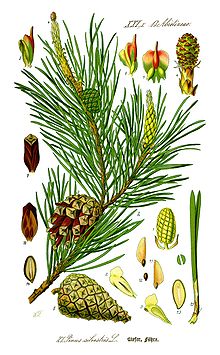
Illustration of needles, cones, and seeds of Scots pine (Pinus sylvestris)
Pines have four types of leaf:
- Seed leaves (cotyledons) on seedlings are borne in a whorl of 4–24.
- Juvenile leaves, which follow immediately on seedlings and young plants, are 2–6 cm long, single, green or often blue-green, and arranged spirally on the shoot. These are produced for six months to five years, rarely longer.
- Scale leaves, similar to bud scales, are small, brown and not photosynthetic, and arranged spirally like the juvenile leaves.
- Needles, the adult leaves, are green (photosynthetic) and bundled in clusters called fascicles. The needles can number from one to seven per fascicle, but generally number from two to five. Each fascicle is produced from a small bud on a dwarf shoot in the axil of a scale leaf. These bud scales often remain on the fascicle as a basal sheath. The needles persist for 1.5–40 years, depending on species. If a shoot is damaged (e.g. eaten by an animal), the needle fascicles just below the damage will generate a bud which can then replace the lost leaves.
Cones[edit]

A growing female cone of a Scots pine on a mountain in Perry County, Pennsylvania.

A fully grown and freshly fallen female pine cone (pinus strobus.)
Pines are mostly monoecious, having the male and female cones on the same tree, though a few species are sub-dioecious, with individuals predominantly, but not wholly, single-sex. The male cones are small, typically 1–5 cm long, and only present for a short period (usually in spring, though autumn in a few pines), falling as soon as they have shed their pollen. The female cones take 1.5–3 years (depending on species) to mature after pollination, with actual fertilization delayed one year. At maturity the female cones are 3–60 cm long. Each cone has numerous spirally arranged scales, with two seeds on each fertile scale; the scales at the base and tip of the cone are small and sterile, without seeds. The seeds are mostly small and winged, and are anemophilous (wind-dispersed), but some are larger and have only a vestigial wing, and are bird-dispersed (see below). At maturity, the cones usually open to release the seeds, but in some of the bird-dispersed species (e.g. whitebark pine), the seeds are only released by the bird breaking the cones open. In others, the seeds are stored in closed ("serotinous") cones for many years until an environmental cue triggers the cones to open, releasing the seeds. The most common form of serotiny is pyriscence, in which a resin binds the cones shut until melted by a forest fire.
Ecology[edit]
Pines grow well in acid soils, some also on calcareous soils; most require good soil drainage, preferring sandy soils, but a few (e.g. lodgepole pine) can tolerate poorly drained wet soils. A few are able to sprout after forest fires (e.g. Canary Island pine). Some species of pines (e.g. bishop pine) need fire to regenerate, and their populations slowly decline under fire suppression regimens. Several species are adapted to extreme conditions imposed by elevation and latitude (e.g. Siberian dwarf pine, mountain pine, whitebark pine, and the bristlecone pines). The pinyon pines and a number of others, notably Turkish pine and gray pine, are particularly well adapted to growth in hot, dry semidesert climates.[citation needed]
The seeds are commonly eaten by birds, such as grouse, crossbills, jays, nuthatches, siskins, and woodpeckers, and by squirrels. Some birds, notably the spotted nutcracker, Clark's nutcracker, and pinyon jay, are of importance in distributing pine seeds to new areas. Pine needles are sometimes eaten by some Lepidoptera (butterfly and moth) species (see list of Lepidoptera that feed on pines), the Symphytan species pine sawfly, and goats.[citation needed]
Pine pollen may play an important role in the functioning of detrital food webs.[8] Nutrients from pollen aid detritivores in development, growth, and maturation, and may enable fungi to decompose nutritionally scarce litter.[8] Pine pollen is also involved in moving plant matter between terrestrial and aquatic ecosystems.[8]
Manners[edit]
This section needs additional citations for verification. Please help improve this article by adding citations to reliable sources. Unsourced material may be challenged and removed. (December 2011) (Learn how and when to remove this template message)
|
Lumber and construction[edit]
Pines are among the most commercially important tree species valued for their timber and wood pulp throughout the world. In temperate and tropical regions, they are fast-growing softwoods that grow in relatively dense stands, their acidic decaying needles inhibiting the sprouting of competing hardwoods. Commercial pines are grown in plantations for timber that is denser, more resinous, and therefore more durable than spruce (Picea). Pine wood is widely used in high-value carpentry items such as furniture, window frames, panelling, floors, and roofing, and the resin of some species is an important source of turpentine.
Because pines have no insect- or decay-resistant qualities after logging, they are generally recommended for construction purposes as indoor use only (ex. indoor drywall framing). This wood left outside can be expected to last no more than 12–18 months depending on the local climate. It is commonly referred to by several different names which include North American timber, spruce/pine/fir (SPF), and whitewood.
Ornamental uses[edit]
Many pine species make attractive ornamental plantings for parks and larger gardens with a variety of dwarf cultivars being suitable for smaller spaces. Pines are also commercially grown and harvested for Christmas trees. Pine cones, the largest and most durable of all conifer cones, are craft favorites. Pine boughs, appreciated especially in wintertime for their pleasant smell and greenery, are popularly cut for decorations. Pine needles are also used for making decorative articles such as baskets, trays, pots, etc, and during the U.S. Civil War, the needles of the longleaf pine "Georgia pine" were widely employed in this.[9]This originally Native American skill is now being replicated across the world. Pine needle handicrafts are made in the US, Canada, Mexico, Nicaragua, and India.
Wildlife[edit]
Pine needles serve as food for various Lepidoptera. See List of Lepidoptera that feed on pines. Several species are attacked by nematodes, causing pine wilt disease, which can kill some quickly.
Farming[edit]
When grown for sawing timber, pine plantations can be harvested after 30 years, with some stands being allowed to grow up to 50 (as the wood value increases more quickly as the trees age). Imperfect trees (such as those with bent trunks or forks, smaller trees, or diseased trees) are removed in a "thinning" operation every 5-10 years. Thinning allows the best trees to grow much faster, because it prevents weaker trees from competing for sunlight, water, and nutrients. Young trees removed during thinning are used for pulpwood, while most older ones are good enough for saw timber.
The final wood quality can be improved by pruning small branches at ages 5, 7, and 9. Pruning usually goes up to a height of 6 metres (20 ft). This results in smooth timber with no knots, which is considerably more valuable. [10]
A 30-year-old commercial pine tree grown in good conditions will be about 0.3 m (1.0 ft) in diameter and about 20 m (66 ft) high. After 50 years, the same tree will be about 0.5 m (1.6 ft) in diameter and 25 m (82 ft) high, and its wood will be worth about seven times as much as the 30-year-old tree. [11]
Trees are planted 3-4 m apart, or about 1000 per hectare (100,000 per km2).
Food[edit]

Edible seeds of the Korean pine (Pinus koraiensis)
Some species have large seeds, called pine nuts, that are harvested and sold for cooking and baking. They are an essential ingredient of pesto alla genovese.
The soft, moist, white inner bark (cambium) found clinging to the woody outer bark is edible and very high in vitamins A and C. It can be eaten raw in slices as a snack or dried and ground up into a powder for use as an ersatz flour or thickener in stews, soups, and other foods, such as bark bread. Adirondack Indians got their name from the Mohawk Indian word atirú:taks, meaning "tree eaters".
A tea made by steeping young, green pine needles in boiling water (known as tallstrunt in Sweden) is high in vitamins A and C. In eastern Asia, pine and other conifers are accepted among consumers as a beverage product, and used in teas, as well as wine.[12]
Pine needles from Pinus densiflora were found to contain 30.54 mg/g of proanthocyanidins when extracted with hot water.[13] Comparative to ethanol extraction resulting in 30.11 mg/g, simply extracting in hot water is preferable.
Proanthocyanidins, the nutrient for which wine and grapes are famed and grapeseed extract is used medicinally[14], is in nearly the same quantity in pine needles of P. densiflora as it is in grape juice (35 mg/g). Grapeseed extract from cultivated grapes is 48.9 to 96.7 mg/g.[15]
Folk medicine[edit]
Pine has been listed as one of the 38 substances used to prepare Bach flower remedies,[16] a kind of alternative medicinepromoted[clarification needed by whom?] for its effect on health. However, according to Cancer Research UK, "there is no scientific evidence to prove that flower remedies can control, cure or prevent any type of disease, including cancer".[17]
Subscribe to:
Comments (Atom)
Popular Posts
-
KAWA KAWA - Is a Moari name of plant in English means Macropiper ( Source :http://www.herbs.org.nz) Family Piperaceae Descrip...
-
( Source: oranewzealand.com) Kumarahou (Pomaderris kumeraho) To soothe irritating coughs, help expel phlegm on the chest or heal ...
-
Tea Tree The manuka or ‘tea tree’ is a common small tree or shrub found around New Zealand, particularly in drier areas where it i...
-
This hidden lake is situated on limestone hill county in Waitomo, and is contiguous with two QEII sites (S16068, S16069 ), and Orahiri Scen...
-
Nikau From Wikipedia, the free encyclopedia For the New Zealand rugby league player, see Tawera Nikau . Nīkau Conservation...
-
From Wikipedia, the free encyclopedia This article is about the tree. For other uses of the term "pine", see Pine (disa...




